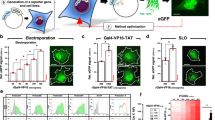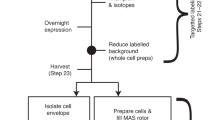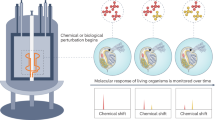Abstract
In-cell NMR spectroscopy is a unique tool for characterizing biological macromolecules in their physiological environment at atomic resolution. Recent progress in NMR instruments and sample preparation methods allows functional processes, such as metal uptake, disulfide-bond formation and protein folding, to be analyzed by NMR in living, cultured human cells. This protocol describes the necessary steps to overexpress one or more proteins of interest inside human embryonic kidney 293T (HEK293T) cells, and it explains how to set up in-cell NMR experiments. The cDNA is transiently transfected as a complex with a cationic polymer (DNA:PEI (polyethylenimine)), and protein expression is carried on for 2–3 d, after which the NMR sample is prepared. 1H and 1H–15N correlation NMR experiments (for example, using band-selective optimized flip-angle short-transient heteronuclear multiple quantum coherence (SOFAST-HMQC)) can be carried out in <2 h, ensuring cell viability. Uniform 15N labeling and amino-acid-specific (e.g., cysteine, methionine) labeling schemes are possible. The entire procedure takes 4 d from cell culture seeding to NMR data collection.
This is a preview of subscription content, access via your institution
Access options
Subscribe to this journal
Receive 12 print issues and online access
$259.00 per year
only $21.58 per issue
Buy this article
- Purchase on Springer Link
- Instant access to full article PDF
Prices may be subject to local taxes which are calculated during checkout





Similar content being viewed by others
References
Reckel, S., Hänsel, R., Löhr, F. & Dötsch, V. In-cell NMR spectroscopy. Prog. Nucl. Magn. Reson. Spectrosc. 51, 91–101 (2007).
Selenko, P. & Wagner, G. Looking into live cells with in-cell NMR spectroscopy. J. Struct. Biol. 158, 244–253 (2007).
Inomata, K. et al. High-resolution multi-dimensional NMR spectroscopy of proteins in human cells. Nature 458, 106–109 (2009).
Maldonado, A.Y., Burz, D.S. & Shekhtman, A. In-cell NMR spectroscopy. Prog. Nucl. Magn. Reson. Spectrosc. 59, 197–212 (2011).
Banci, L. et al. Atomic-resolution monitoring of protein maturation in live human cells by NMR. Nat. Chem. Biol. 9, 297–299 (2013).
Sakakibara, D. et al. Protein structure determination in living cells by in-cell NMR spectroscopy. Nature 458, 102–105 (2009).
Waudby, C.A. et al. In-cell NMR characterization of the secondary structure populations of a disordered conformation of α-synuclein within E. coli cells. PLoS One 8, e72286 (2013).
Monteith, W.B. & Pielak, G.J. Residue level quantification of protein stability in living cells. Proc. Natl. Acad. Sci. USA 111, 11335–11340 (2014).
Burz, D.S., Dutta, K., Cowburn, D. & Shekhtman, A. Mapping structural interactions using in-cell NMR spectroscopy (STINT-NMR). Nat. Methods 3, 91–93 (2006).
Majumder, S. et al. Probing protein quinary interactions by in-cell nuclear magnetic resonance spectroscopy. Biochemistry 54, 2727–2738 (2015).
Monteith, W.B., Cohen, R.D., Smith, A.E., Guzman-Cisneros, E. & Pielak, G.J. Quinary structure modulates protein stability in cells. Proc. Natl. Acad. Sci. USA 112, 1739–1742 (2015).
Selenko, P., Serber, Z., Gadea, B., Ruderman, J. & Wagner, G. Quantitative NMR analysis of the protein G B1 domain in Xenopus laevis egg extracts and intact oocytes. Proc. Natl. Acad. Sci. USA 103, 11904–11909 (2006).
Ogino, S. et al. Observation of NMR signals from proteins introduced into living mammalian cells by reversible membrane permeabilization using a pore-forming toxin, streptolysin O. J. Am. Chem. Soc. 131, 10834–10835 (2009).
Theillet, F.-X. et al. Structural disorder of monomeric α-synuclein persists in mammalian cells. Nature 530, 45–50 (2016).
Selenko, P. et al. In situ observation of protein phosphorylation by high-resolution NMR spectroscopy. Nat. Struct. Mol. Biol. 15, 321–329 (2008).
Bodart, J.-F. et al. NMR observation of Tau in Xenopus oocytes. J. Magn. Reson. 192, 252–257 (2008).
Pielak, G.J. et al. Protein nuclear magnetic resonance under physiological conditions. Biochemistry 48, 226–234 (2009).
Hänsel, R., Foldynová-Trantírková, S., Dötsch, V. & Trantírek, L. Investigation of quadruplex structure under physiological conditions using in-cell NMR. Top. Curr. Chem. 330, 47–65 (2013).
Danielsson, J. et al. Pruning the ALS-associated protein SOD1 for in-cell NMR. J. Am. Chem. Soc. 135, 10266–10269 (2013).
Bertrand, K., Reverdatto, S., Burz, D.S., Zitomer, R. & Shekhtman, A. Structure of proteins in eukaryotic compartments. J. Am. Chem. Soc. 134, 12798–12806 (2012).
Hamatsu, J. et al. High-resolution heteronuclear multidimensional NMR of proteins in living insect cells using a baculovirus protein expression system. J. Am. Chem. Soc. 135, 1688–1691 (2013).
Banci, L., Barbieri, L., Luchinat, E. & Secci, E. Visualization of redox-controlled protein fold in living cells. Chem. Biol. 20, 747–752 (2013).
Barbieri, L., Luchinat, E. & Banci, L. Structural insights of proteins in sub-cellular compartments: in-mitochondria NMR. Biochim. Biophys. Acta 1843, 2492–2496 (2014).
Luchinat, E. et al. In-cell NMR reveals potential precursor of toxic species from SOD1 fALS mutants. Nat. Commun. 5, 5502 (2014).
Barbieri, L., Luchinat, E. & Banci, L. Protein interaction patterns in different cellular environments are revealed by in-cell NMR. Sci. Rep. 5, 14456 (2015).
Mercatelli, E., Barbieri, L., Luchinat, E. & Banci, L. Direct structural evidence of protein redox regulation obtained by in-cell NMR. Biochim. Biophys. Acta 1863, 198–204 (2016).
Luchinat, E., Secci, E., Cencetti, F. & Bruni, P. Sequential protein expression and selective labeling for in-cell NMR in human cells. Biochim. Biophys. Acta 1860, 527–533 (2016).
Banci, L. et al. Human superoxide dismutase 1 (hSOD1) maturation through interaction with human copper chaperone for SOD1 (hCCS). Proc. Natl. Acad. Sci. USA 109, 13555–13560 (2012).
Aricescu, A.R., Lu, W. & Jones, E.Y. A time- and cost-efficient system for high-level protein production in mammalian cells. Acta Crystallogr. D Biol. Crystallogr. 62, 1243–1250 (2006).
Ye, J. et al. High-level protein expression in scalable CHO transient transfection. Biotechnol. Bioeng. 103, 542–551 (2009).
Aruffo, A. Transient expression of proteins using COS cells. Curr. Protoc. Mol. Biol. Chapter 16, Unit 16.12 (2002).
Seiradake, E., Zhao, Y., Lu, W., Aricescu, A.R. & Jones, E.Y. Production of cell surface and secreted glycoproteins in mammalian cells. Methods Mol. Biol. 1261, 115–127 (2015).
Nettleship, J.E., Rahman-Huq, N. & Owens, R.J. The production of glycoproteins by transient expression in mammalian cells. Methods Mol. Biol. 498, 245–263 (2009).
Kubo, S. et al. A gel-encapsulated bioreactor system for NMR studies of protein-protein interactions in living mammalian cells. Angew. Chem. Int. Ed. Engl. 52, 1208–1211 (2013).
Wen, H., An, Y.J., Xu, W.J., Kang, K.W. & Park, S. Real-time monitoring of cancer cell metabolism and effects of an anticancer agent using 2D in-cell NMR spectroscopy. Angew. Chem. Int. Ed. Engl. 54, 5374–5377 (2015).
Hwang, T.L. & Shaka, A.J. Water suppression that works. Excitation sculpting using arbitrary wave-forms and pulsed-field gradients. J. Magn. Reson. Ser. A 112, 275–279 (1995).
Piotto, M., Saudek, V. & Sklenár, V. Gradient-tailored excitation for single-quantum NMR spectroscopy of aqueous solutions. J. Biomol. NMR 2, 661–665 (1992).
Schanda, P. & Brutscher, B. Very fast two-dimensional NMR spectroscopy for real-time investigation of dynamic events in proteins on the time scale of seconds. J. Am. Chem. Soc. 127, 8014–8015 (2005).
Tugarinov, V., Hwang, P.M., Ollerenshaw, J.E. & Kay, L.E. Cross-correlated relaxation enhanced 1H[bond]13C NMR spectroscopy of methyl groups in very high molecular weight proteins and protein complexes. J. Am. Chem. Soc. 125, 10420–10428 (2003).
Acknowledgements
This work was supported by iNEXT (grant agreement 653706), funded by the Horizon 2020 Programme of the European Union; by MEDINTECH: Tecnologie convergenti per aumentare la sicurezza e l'efficacia di farmaci e vaccini (grant CTN01_00177_962865); by Instruct, part of the European Strategy Forum on Research Infrastructures (ESFRI); and by national member subscriptions. Specifically, we thank the EU ESFRI Instruct Core Centre CERM-Italy.
Author information
Authors and Affiliations
Contributions
L. Barbieri, E.L. and L. Banci conceived the work and designed the experiments. L. Barbieri and E.L. performed the experiments. Specifically, L. Barbieri seeded and transfected the cells, performed the SDS–PAGE and western blot analysis and performed cell counts and viability tests; E.L. optimized the NMR experimental conditions, set up and acquired the NMR experiments and processed and analyzed the NMR data. L. Barbieri, E.L. and L. Banci wrote the manuscript.
Corresponding author
Ethics declarations
Competing interests
The authors declare no competing financial interests.
Integrated supplementary information
Supplementary Figure 1 Grx1 is not detected in the in-cell NMR spectra.
1H-15N SOFAST-HMQC NMR spectra of (a) cells expressing [U-15N]-labelled Grx1 and (b) the corresponding cell lysate. In the spectrum (a) the signals arising from Grx1 are not detected, owing to the interaction with other cellular components. The two spectra were acquired with identical parameters; background subtraction was not performed. (c) Western blot of the cell lysate analyzed in b (+) together with a control sample (–).
Supplementary Figure 2 Western blots.
Full western blots corresponding to (a) Fig. 3b and (b) Fig. 3d. An unrelated sample is marked with an asterisk.
Supplementary information
Supplementary Information
Supplementary Figures 1 and 2 (PDF 303 kb)
Rights and permissions
About this article
Cite this article
Barbieri, L., Luchinat, E. & Banci, L. Characterization of proteins by in-cell NMR spectroscopy in cultured mammalian cells. Nat Protoc 11, 1101–1111 (2016). https://doi.org/10.1038/nprot.2016.061
Published:
Issue Date:
DOI: https://doi.org/10.1038/nprot.2016.061
This article is cited by
-
Protein structure determination in human cells by in-cell NMR and a reporter system to optimize protein delivery or transexpression
Communications Biology (2022)
-
Characterizing proteins in a native bacterial environment using solid-state NMR spectroscopy
Nature Protocols (2021)
-
Protein in-cell NMR spectroscopy at 1.2 GHz
Journal of Biomolecular NMR (2021)
-
The precious fluorine on the ring: fluorine NMR for biological systems
Journal of Biomolecular NMR (2020)
-
The cysteine-reactive small molecule ebselen facilitates effective SOD1 maturation
Nature Communications (2018)
Comments
By submitting a comment you agree to abide by our Terms and Community Guidelines. If you find something abusive or that does not comply with our terms or guidelines please flag it as inappropriate.



